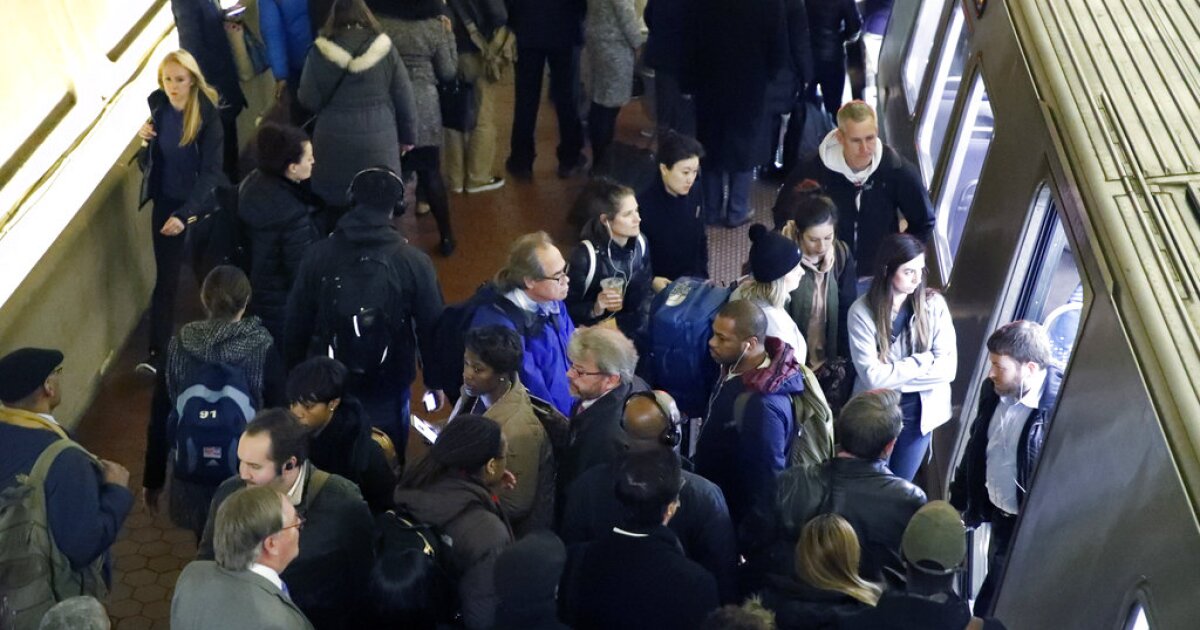

Metro trains are more crowded than usual, and that is not expected to change any time soon.
Since Labor Day, trains are 35% more crowded during 8 a.m. and 13% more crowded at 5 p.m. — two peak periods of riders, according to Washington Metropolitan Area Transit Authority data.
Most of the crowding is occurring on the Red Line, between NoMa and Metro Center and between Farragut North and Van Ness. It is also occurring on the Orange and Silver lines between Virginia Square and Farragut West.
DC METRO WORKERS RAILED THROUGH WITHOUT RECERTIFICATION, INVESTIGATION SHOWS
Metro’s Yellow Line will be shut down between October 2022 and May 2023. To offset the large crowds, Metro added approximately two trains on the Red, Orange, and Silver lines. However, that does not seem to be enough.
Metro General Manager Randy Clarke said during a board meeting on Thursday that the crowding comes from the removal of several 7000-series trains after a derailment occurred in October 2021.
Metro pulled 60% of the Blue Line trains immediately after the derailment on Wednesday. That December, Metro removed all 7000-series trains with no return date set.
Clarke said that the Metrorail Safety Commission authorized them to run 20 of the 7000-series trains at any time, but because of overlapping requirements, Metro can only run 16 at a time.
“Ridership is escalating quickly, and we have little optionality to address that,” Clarke said during the meeting. “We are focused on [bringing back 7000-series trains] all day, every day. And we’re working closely as possible with the [Washington Metrorail Safety Commission] on that.”
Around 10 to 12 new series trains are running per day, according to recent data from MetroHero, an app that tracks trains servicing passengers.
Nerd talk: #WMATA has a certain number of 7000-series trains it can make available for service on a given day. What we track is how many of those trains are actually observed servicing passengers—beyond terminal stations like Glenmont, Shady Grove, etc.—at any given time. https://t.co/0bhqexzBgY
— MetroHero (@dcmetrohero) October 13, 2022
A fiscal year 2022 Metro report showed that 79% of Metrorail passengers completed their trips on time, with the target being 92%. Metro attributes the drop in on-time trips to the derailments, as the on-time performance prior to the derailment sat at 91.5%.
Metro’s goal for the next year is to bring times down significantly, aiming for five minutes on the Red Line and 10 minutes for all other lines.
Clarke said that while he has heard of riders asking for more services and less crowded trains, he knows ridership will only grow, and as of now, there are no more trains to put on the rails.
During the meeting, there was a discussion on the inclusion of trains from the 1980s. However, both Clarke and Metro Board Chairman Paul Smedberg agreed that running the older cars could lead to other problems.
“I’m really concerned about the continued reliance on these older legacy vehicles and the safety issues that may come down if we were just continually running these cars,” Smedberg said, per DCist.
Satisfaction for the Metro for fiscal year 2022 sat at 69%, compared to the target of 84%. Riders reported that their dissatisfaction came from the cut in service trains, as well as concerns over rising crime and safety.
CLICK HERE TO READ MORE FROM THE WASHINGTON EXAMINER
The Council of the District of Columbia’s transportation committee passed a bill in September that, if approved by the entire council, will provide $100 to district residents per month, giving riders either a free or significantly cheaper public transportation option. The bill is expected to be discussed sometime in October.





